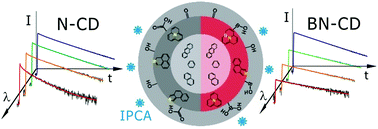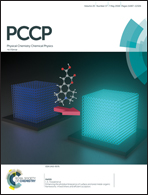Time-resolved spectroscopy of the ensembled photoluminescence of nitrogen- and boron/nitrogen-doped carbon dots†
Abstract
Carbon dots (CDs) have potential applications in various fields such as energy, catalysis, and bioimaging due to their strong and tuneable photoluminescence (PL), low toxicity, and robust chemical inertness. Although several PL mechanisms have been proposed, the origin of PL in CDs is still in debate because of the ensembled nature of the heterogeneous luminophores present in the CDs. To unravel the origin of PL in CDs, we performed time-resolved spectroscopy on two types of CDs: nitrogen-doped (N-CD) and boron–nitrogen co-doped (BN-CD). The PL decays were fitted by stretched exponential functions to estimate the distribution of the decay kinetics in the CDs, which have different PL lifetime distributions. Both CDs displayed main, blue emission decaying in 15 ns, which originates from the dominant molecular state. The analysis of the non-exponential PL decay using stretched exponential fits revealed that the functional surface luminophores are of less variety but of more environmental heterogeneity and have much lower populations in BN-CD than in N-CD.

- This article is part of the themed collection: 2018 PCCP HOT Articles


 Please wait while we load your content...
Please wait while we load your content...